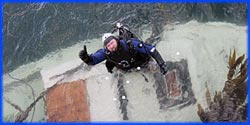


Premier Date: June 29, 2011
confirmed
Adam and Jamie built a 15 ft (5 m) deep cylindrical tank, fitted it with pressure sensors at four depths, and filled it with water. Firing an underwater .357 Magnum revolver loaded with blanks to generate shock waves, they found that the sensor nearest the surface gave the lowest readings.
For full-scale tests, they used a mast fitted with sensors at depths of 0, 0.5, 2.5, 15, and 25 ft (0, 0.15, 0.76, 4.6, and 7.6 m). The first several depths were intended to represent the depth at which a swimmer’s torso would be submerged if he were floating or treading water. A 10 lb (5 kg) charge of TNT was set off at a depth of 15 ft (5 m) and at a certain horizontal distance from the sensors (30, 70, or 150 ft (9, 21, or 46 m)).
Using a pressure threshold of 87 psi (corresponding to a 50% mortality rate from the shock wave), Adam and Jamie found that a person 30 ft (9 m) from the explosion would survive if floating, but the pressures at greater depths were likely to cause death. At longer distances, readings at all depths fell below 87 psi. Based on the 30-foot results, they declared the myth confirmed. Jamie attributed these results to the fact that much of the energy from the underwater pressure wave dissipated into transverse waves when it reached the surface.
plausible
Kari spoke with antique armor expert Greg Martin, who explained that paper armor was in use as early as 600 BC and was built up from layers that may have been impregnated with resin or shellac. The Build Team tested several formulations for penetration resistance and found that a thick layer of folded paper, with no resin, gave the best results.
Using an armor sample of either 1/2 in (13 mm) paper or 1/32 in (1 mm) steel placed over a block of clay, they tested resistance to blunt force, swords, and arrows. The paper did as well as steel in the sword and arrow tests, failing only the blunt-force test, so the team decided to build a full suit of paper armor to match against a period-accurate steel counterpart.
Each team member ran one of three timed courses in both armor types to evaluate speed, endurance, and agility; paper outperformed steel in all three. Finally, they attacked the suits with arrows, swords, and two different firearms—an 18th-century flintlock pistol and a 19th-century .45 revolver. Both armor types resisted every attack except the .45, leading the team to classify the myth as plausible. They pointed out, though, that the paper armor could quickly begin to disintegrate if it got wet or took repeated blows (both of which happened during the full-scale tests).
Previous: Episode 169: Let There Be Light